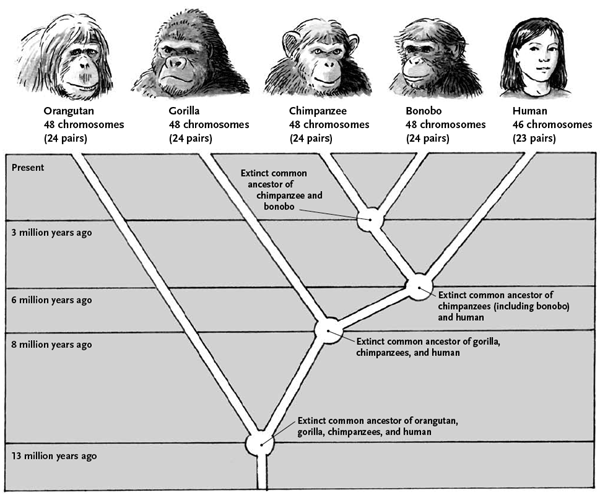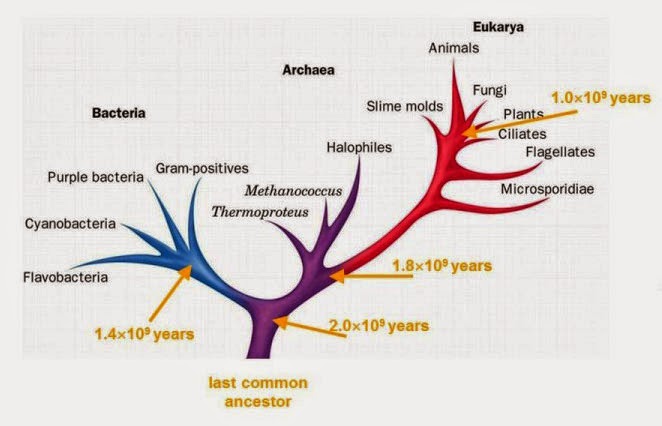Biology concepts – common descent, evolution, direct descent, fungi, undulipodia, amphibians, phylogenetics
Martel, A., Spitzen-van der Sluijs, A., Blooi, M., Bert, W., Ducatelle, R., Fisher, M., Woeltjes, A., Bosman, W., Chiers, K., Bossuyt, F., & Pasmans, F. (2013). Batrachochytrium salamandrivorans sp. nov. causes lethal chytridiomycosis in amphibians Proceedings of the National Academy of Sciences, 110 (38), 15325-15329 DOI: 10.1073/pnas.1307356110
Buck, J., Truong, L., & Blaustein, A. (2011). Predation by zooplankton on Batrachochytrium dendrobatidis: biological control of the deadly amphibian chytrid fungus? Biodiversity and Conservation, 20 (14), 3549-3553 DOI: 10.1007/s10531-011-0147-4
The first life on Earth is a mystery to us. Our best guess right now states that whatever it was, it showed up about 3.5-3.7 billion years ago. It was a cell, let’s call him Luca (last universal common ancestor). Luca had DNA, or maybe just RNA. He had ways to harness and use energy for his purposes, to adapt to changes in his environment, and to reproduce. Luca possessed all seven of the characteristics of life.
Every living thing you see around you, and all the living things you can’t see around you, are descended from Luca. But here is the part that’s a little harder to understand – it hasn’t been a straight line from Luca through all other life forms to you.
It’s the difference between common descent and direct descent. Just because humans and pine trees have a common ancestor, it doesn’t mean that we are direct descendents of the same organism.
At some point, about 3.5 billion years ago, archaeal prokaryotes were recognizable. Luca gave rise to archaea and also to bacteria, but we can’t say that bacteria descended directly from archaea. There are as many differences between archaea and bacteria as there are between you and a pine tree, maybe more. All we can say is that they diverged from a common ancestor, which is why they have somecommon characteristics (from a common ancestor), and manydifferent characteristics (because they diverged).
Archaea, as opposed to bacteria, diverged again and again, giving rise to the rest of the kingdoms we know today – protists, plants, fungi, and animals. The question is, why did they diverge so much, while bacteria stayed so much the same?
I don’t know the answer, but a good theory is the development of organelles. We have talked before about how an archaea swallowed a bacteria, but didn’t destroy it, and how that the eukaroytic nucleus. Another instance in this endosymbiosis theoryformed the mitochondrion. The more complex something is, the more chance for it to respond to changes in the environment – more adaptation could have led to more divergence.
Through billions of years of struggle and adaptation, the eukaryotic kingdoms emerged – but again, you can’t say that one descended directly from another. Contrast evolution to the alphabet. C follows B, which follows A. Humans like to think linearly. But consider that there may be millions of A’s. Must they all become B’s and then C’s?
No, millions of A’s may breed and remain A’s over the years, while what became a B breeds and stays a B. Maybe later on a couple of A’s breed and have a little baby that looks like neither an A nor a B. Now we have C. B and C or both diverged from A, but B and C are different from one another. They are linked by common, but not direct, descent.
A long time ago, a few archaeal descendents had diverged enough to be called protists. They were eukaryotic now, with organelles and special functions, and were starting to think about working together as multicellular organisms. The protists of that timewere direct descendents of archaea, but the different protists we know today (see our last few posts here, here, and here) aren’t necessarily directly descended from one another or even from the same archaea.
Some protists diverged from one another. Many stayed as protists, even though they might have evolved to different orders or families over the years. However, others became animals, fungi, or the plants. Our last common ancestor with plants was a protist of some sort, so we have a common ancestor with a pine tree, we just can’t draw a direct line through humans and a pine tree to get to that ancestor.
Let’s use undulipodia(eukaryotic flagella and cilia) to illustrate, or confuse, the situation. We saw that protists – most all of the different protists, use flagella or cilia in one or several ways. Flagella and cilia are characteristics that have been retained in the various descendents of archaea…. But didn’t we also say that prokaryotic flagella and eukaryotic undulopdia are completely different in structure and genes? Yes we did - so what gives.
This re-evolving of a flagellum (and cilium) must have occurred pretty quickly, because all the kingdoms that descended from those early eukaryotes (protists, plants, fungi, animals) have them to some degree or another.
Yet, if you look for undulipodia in the fungal species on Earth today, you’ll find them in only one of the five phyla. Again, what gives? Didn’t we just say that fungi descended from undulipodia containing ancestors?
Four of the phylums of fungus are grouped by characteristics, both genetic and life cycle – the Chytridiomycetes, the Zygomycetes, the Ascomycetes and the Basidiomycetes. The fifth phylum is called the imperfect fungi because we haven’t found a life cycle in them that we can place into one of the other four phyla. But when we do, as we have for some individuals imperfect fungi, they usually fall into the ascomycete or basidiomycete phylum.
However, only chytrid fungi have flagella. Every species in every other phylum of fungi has lost their undulipodia. If you are thinking in terms of phylogenetics – what does this suggest to you?
Yes, very good – the chytrids are probably the common ancestor for all the other fungi. Those that didn’t diverge enough and stayed chytrids retained their undulipodia, but at some point, others lost their flagella and kept on changing into all the other phyla of fungi over time.
What is so different about the chytrids that they kept their flagella, while the others were suited to live without them? There must be something about the chytrids life cycle and/or environment that required the retention of their eukaryotic flagella. Well, they all live in water, maybe they need flagella to swim around. But look at the picture of the chytrid on the right, I don’t see a flagellum anywhere there.
The chytridiomycete name comes from the Greek chytridion, which means little pot. The pot holds all their zoospores, their reproductive form. It is the zoospores that have the flagella, so they can swim away and establish themselves somewhere with less competition. But that isn’t a good enough explanation. Many water borne fungi come from the basidiomycete or ascomycete phyla, and they don’t have flagella in any of their life cycle stages. Hmmm.
We have tens of thousands of extant (living today) fungal species, and only about 750 or so have any undulipodia. This makes the chytrids exceptional, and is directly related to their being the common ancestor for all the other fungi. If undulipodia are so important that animals, protists, some fungi, and even some plants have them, then why is it that so many fungi seem to get along fine without them? Maybe they’re the exception.
Let’s tell one story of how the chytrid flagella are important. A species of chytrid, called Batrachochytrium dendrobatidis,is responsible for perhaps the largest vertebrate mass extinction in the history of the Earth - and it's going on right now. Most chytrids are sabrophyitc, meaning they eat dead tissue, but a few are parasitic, mostly on plants.
You may have heard of the frightening loss of amphibian diversity on the past decades. The reasons for this are known to be several, including toxic pollutants, climate change, and habitat destruction. But B. dendrobatidis has played a significant role as well. Fortunately, a 2011 study showed that a water flea has a voracious appetite for our frog foe and might be used as a control measure. Unfortunately, a 2013 study showed that chytrid-susceptible amphibians may be succumbing to at least two different, and probably more, species of Batrachohytria. So the problem is probably more complex than we thought.
And yes, you read correctly a couple of paragraphs above. Some plants have cells that have flagella. There are moving plants cells! Those will be our exceptions for next week.
For more information or classroom activities, see:
Common descent –
http://www.ibtimes.co.uk/four-billion-year-old-mystery-last-universal-common-ancestor-solved-1460866
Fungi –
Amphibian collapse –
Phylogenetics –


























